The ingredients are very similar to the Joy of Cooking recipe, but the proportions are quite different with more sugar and more peanut butter.
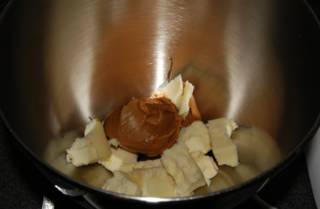 To make about two dozen cookies, start with 1/2 cup peanut butter and 1/2 cup unsalted butter. This time around I chose to use Skippy brand peanut butter. There is some concern that commercial peanut butters contain trans fatty acids since partially hydrogenated vegetable oils are used to stabilize the butter (preventing separation). On the other hand, it is common to find higher levels of aflatoxins in old fashioned peanut butter leading to a higher risk of liver cancer (if consumed regularly). According to both Skippy's nutrition FAQ and the USDA claim that there are no measurable amounts of trans fats present in commercial peanut butter. Skippy explains that the vegetable oils are almost completely fully hydrogenated (which as you remember from the Saturated Fats article cannot be trans fats since fully hydrogenated fats are chemically the same as saturated fats).
To make about two dozen cookies, start with 1/2 cup peanut butter and 1/2 cup unsalted butter. This time around I chose to use Skippy brand peanut butter. There is some concern that commercial peanut butters contain trans fatty acids since partially hydrogenated vegetable oils are used to stabilize the butter (preventing separation). On the other hand, it is common to find higher levels of aflatoxins in old fashioned peanut butter leading to a higher risk of liver cancer (if consumed regularly). According to both Skippy's nutrition FAQ and the USDA claim that there are no measurable amounts of trans fats present in commercial peanut butter. Skippy explains that the vegetable oils are almost completely fully hydrogenated (which as you remember from the Saturated Fats article cannot be trans fats since fully hydrogenated fats are chemically the same as saturated fats).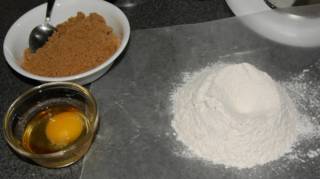 Sift 1-1/4 cup all purpose flour, 1/2 tsp. baking soda, and 1/4 tsp. salt together. The remaining ingredients are 1/2 cup granulated sugar, 1/2 cup light brown sugar, and 1 egg.
Sift 1-1/4 cup all purpose flour, 1/2 tsp. baking soda, and 1/4 tsp. salt together. The remaining ingredients are 1/2 cup granulated sugar, 1/2 cup light brown sugar, and 1 egg.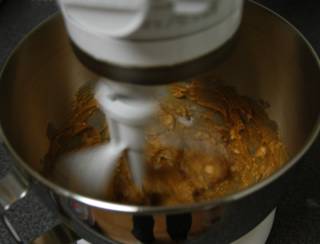 Using a stand mixer, hand mixer, or arms of steel, mix the peanut butter and butter together until relatively smooth. Don't worry about any small lumps of butter that might persist, when we mix in the sugar, the sugar crystals will perforate the butter until it's smooth.
Using a stand mixer, hand mixer, or arms of steel, mix the peanut butter and butter together until relatively smooth. Don't worry about any small lumps of butter that might persist, when we mix in the sugar, the sugar crystals will perforate the butter until it's smooth.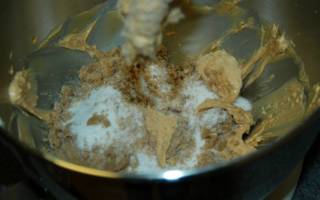 Scrape the bowl down and mix both the granulated sugar and brown sugar into the butter. Mix until smooth.
Scrape the bowl down and mix both the granulated sugar and brown sugar into the butter. Mix until smooth.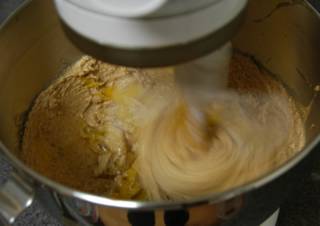 Add the egg to the mixture and mix until integrated.
Add the egg to the mixture and mix until integrated. Once the egg has been mixed in, slowly add the flour as you stir (use the lowest setting on your mixer). I control the flow of flour by sifting the flour onto wax paper (or parchment paper) and folding it over so I can pour easily. By pouring the flour slowly, you won't overwhelm the batter and the flour will properly mix into the batter to form the final dough.
Once the egg has been mixed in, slowly add the flour as you stir (use the lowest setting on your mixer). I control the flow of flour by sifting the flour onto wax paper (or parchment paper) and folding it over so I can pour easily. By pouring the flour slowly, you won't overwhelm the batter and the flour will properly mix into the batter to form the final dough.Related Articles
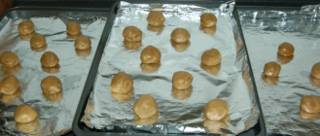 Form the dough into about two dozen 1 inch balls. I do this by picking up a lump of dough, rolling it between my hands, and finishing up by tossing the ball lightly between my hands. Place the balls of dough onto a greased or lined cookie sheet. In the pictures below, I lined the cookie sheet with aluminum foil (parchment paper works well also).
Form the dough into about two dozen 1 inch balls. I do this by picking up a lump of dough, rolling it between my hands, and finishing up by tossing the ball lightly between my hands. Place the balls of dough onto a greased or lined cookie sheet. In the pictures below, I lined the cookie sheet with aluminum foil (parchment paper works well also). Flatten each of the balls with a fork.
Flatten each of the balls with a fork.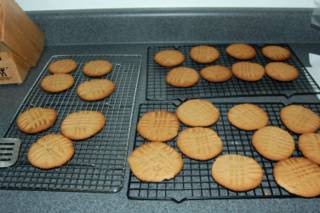 Place one cookie sheet at a time in the center rack of an oven preheated to 375°F. Bake for nine minutes and remove. Let stand on cookie sheet for one minute, then transfer to cooling racks to cool.
Place one cookie sheet at a time in the center rack of an oven preheated to 375°F. Bake for nine minutes and remove. Let stand on cookie sheet for one minute, then transfer to cooling racks to cool.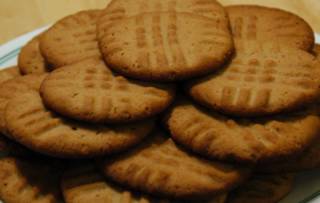 These peanut butter cookies come out golden brown with a light crispiness that melts in your mouth.
These peanut butter cookies come out golden brown with a light crispiness that melts in your mouth.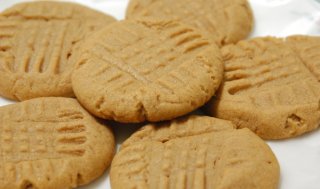 For a soft and chewy peanut butter cookie, make sure you refrigerate the dough first. Then form dough balls and press down with a fork as before. Then, simply refrigerate the uncooked cookies for at least fifteen minutes to firm it back up. Then with the oven preheated to 300°F, slide one tray in at a time for a baking time of 15 minutes.
For a soft and chewy peanut butter cookie, make sure you refrigerate the dough first. Then form dough balls and press down with a fork as before. Then, simply refrigerate the uncooked cookies for at least fifteen minutes to firm it back up. Then with the oven preheated to 300°F, slide one tray in at a time for a baking time of 15 minutes.The reason this trick works is that the butter in the dough is not as fluid when cold. Warm dough will spread out more during the first few minutes of cooking, resulting in a thinner, crispier cookie. Starting the cookie sheet and dough cold, reduces the spread, making thicker cookies. The lower oven temperature keeps the outside of the cookie from getting too crunchy before the inside of the thicker cookie finishes cooking. It should be noted that if you want to make soft cookies of the same diameter as the crispy cookies, you'll need to use a little more dough in each so the spread ends up the same.
Peanut Butter Cookies
Cookie Dough
| 1/2 cup (130 g) peanut butter | mix | mix | mix | slowly add while stirring | refrigerate at least 1 hour |
| 1/2 cup (110 g) unsalted butter | |||||
| 1/2 cup (100 g) granulated sugar | |||||
| 1/2 cup (110 g) brown sugar | |||||
| 1 egg | |||||
| 1-1/4 cup (160 g) all purpose flour | sift | ||||
| 1/2 tsp. (2.3 g) baking soda | |||||
| 1/4 tsp. (1.5 g) salt | |||||
Light & Crispy Cookies (makes about 24 cookies)
| Preheat oven to 375°F (190°C) | |||
| 1 batch cookie dough | form 1 in. balls | flatten with fork | bake 375°F 9 min. |
Soft & Chewy Cookies (makes about 18 cookies)
| Preheat oven to 300°F (150°C) | ||||
| 1 batch cookie dough | form 1.1 in. balls | flatten with fork | refrigerate 15 min. | bake 300°F 15 min. |
Related Articles

I have to admit I hadn't given your site a good look until today, and I am amazed! Your receipt format is so simple and obvious that even I can effortlessly understand it (and that is saying something).
Keep up the good work. Signe and I think of you and Tina often.
Take care,
trv
The use of grams is not so much for precision as to provide readers from outside of the United States an ability to cook th recipes. A lot of kitchens don't have dry measuring cups, so I do the conversions now.
Using inches is not imprecise, it's just not metric and I apologize for forgetting to convert inches to cm for people who are not familiar with U.S. units.
Doesn't Costco Japan sell peanut butter? Next time someone makes a Costco run, you can bribe them in bringing back some.
I checked amazon and found that they do sell Skippy Creamy Peanut Butter through a third party company, but they don't ship to Japan. There's got to be a way to get peanut butter out to where you are...
Btw, im love ur site and visit it regularly...keep up d good work :)
Jack
Out of three batches, I used half the butter for the last two and didn't notice much difference in the taste. Also, a mixer was an overkill since there is so little dough (when I tried I got bits of dough all over the kitchen). A mixing spoon worked much better and didn't tire my hand much.
I plan on making some oatmeal cookies next, then branching out to muffins and bread!
Proportionally, this recipe uses more sugar and peanut butter than the Joy of Cooking. The Joy of Cooking recipe yields two batches of cookies, while this recipe is for one batch. My edition of joy of cooking calls for 2/3 cup peanut butter resulting in 1/3 cup per batch. Starting with 1 cup peanut butter as your edition recommends, would result in the same 1/2 cup of peanut butter.
I also wanted to add that, being a professional cook, I admit I have a difficult time understanding any measurements in cups. I think it's dreadfully unprecise! Concerning the cookies, Oboeman might have tried to point out that you should mention the size of the balls in weight, not in size.
Great work!
Take care,
Alex
Also...regarding the comment listing cookie size by weight...how could you tell how big to make them if you don't won a cooking scale? I don't know anyone who does own one.
I have no desire to drop the U.S. units since I do live in the U.S. and cater to a mostly U.S. audience - but I have been making sure that I include mass when appropriate. I actually cook with a mix of volume and mass measurements depending on which is faster or more expedient to the task.
-- peace out - -
me
http://velma17.blogspot.com/
As for using other nut butters, I have had wonderful results from almond butter. (Places like Sunflower market, Sprouts, or other natural food stores, I'm sure, you can grind your own-- resulting in a slightly textured, very healthy butter that is perfect for cookies. A bit on the pricey side, though!!)
Since there's no added salt or hydrogenated oils, this is a great alternative for people looking for a slightly heathier cookie. Also, great for people with peanut allergies.
(You might even be able to make your own coarse nut butter in a food processor, though I have yet to try this.)
Good luck, and hope you enjoy the other butters as much as I do!!
(All my cook books are in storage)
Pulled up peanut butter cookies..woke him up & we were off by 7:30 am we were finished & off to school with wonderful tasting cookies. I did not get to refrigerate them but they still came out great.
You have saved my reputation & my son is the hero.
Thank you, Thank you, Thank you.!!!
Most Sincerely, Di
OK stuff like flour should be weighed as it can settle in the jar/packet and therefore a cup isn't always a cup , but a gram is always a gram.
Gotta love Good eats for little tidbits of info ;)
Ab61qsolutely the best! 10 minutes with 1 inch cookie scoop. Thanks for the great recipe!
Beachgranny
Kayla
It used to be cost prohibitive, but the past ten or fifteen years or so, the price has come down to be competeive with the standard variety. I've long been meaning to try making peanut butter cookies with it, but just haven't gotten to it yet.
The "Old fashioned" peanut butter that I refer to is the non-(regular) Skippy/Jif brand stuff which separates. The FDA found in random testing that in general those peanut butters have a higher aflatoxin content than the "ultra-processed" varieties that we generally think of. This is one of those cases where processed may be better for you than natural/traditional. In any case, processed peanut butter turns out to be a not-so-processed food when we compare it to other processed foods.
1 cup peanut butter (chunky is best)
1 cup sugar
1 egg
As every engineer knows, less is more ;)
I'm all for simple, but quality trumps simplicity in my book :)
Any advice?
Many thanks!
Best,
Deb
P.S. Michael, we eventually went with the Global knives -- I blogged about them, too. ;)
or add more butter a stick and a half perhaps per batch.
I divided the dough into two. Baked one batch immediately (couldn't wait :P) and refrigerated the other batch to try out the two versions you mentioned.
Thanks.
Also, I don't have a mixer so I've been using my food processor to blend all the ingredients, and I get a very smooth, somewhat sticky dough that makes great chewy cookies.
PS the ingredients chart at the end of each recipe is inspirational!
THANK YOU!!
SHELBY :D :D :) ;)
im only like 13 and its EASY to do :)
wow your amazing
they tasted great. the dough tasted GOOD
sending to a friend overseas to make a batch for herself in Europe!
Sounds like you made them correctly. Your fingers will become greasy as you mold the dough. You can try reducing butter, but at some point you'll be able to detect a texture and flavor difference. This is up to personal preference and will require some experimenting. For some people, they can make an all peanut butter cookie and others need all the butter. Try making a batch with reduced butter and see if you still like it. If so, reduce th ebutter some more and keep going. Of course, peanut butter has a lot of oil in it (it is mostly fat), so your fingers will always be greasy. At some point you won't be ablet o mold the dough without the dough sticking to your fingers - so dip your hand in water to help keep everything off your fingers as you work.
Of course when I saw this site on Google, I came here right away to check on it, and my Wife loved it so much as well, she is planning on posting it to all her physics friends tomorrow on her blog site.
Anyway, Back to topic. Micheal, Thank you for a BRILLENT site. Everything from your explainations to the recipe summary cards is out of this world and if somebody cant understand it.. well I won't comment
However with regards to the comments made some time ago (almost a year from me finding your site) I would like to let the person who made the comments about you using inches. Know that any engineer should know how to convert between imperial and metric systems. If any engineer around the world (and I use metric BTW where I live) doesn't know what an inch is.. they need to go back to varsity.. if not junior school
Why do we press peanut butter cookies with a fork before baking them?
According to Dr. Mercola's book Total Health Program, not only are aflatoxins a problem in peanut butter, but also peanuts have one of the highest pesticide residues of any crop. He says that the natural brand "Arrowhead Mills", uses peanuts grown in New Mexico
But I might not pour off the oil if you'll be baking as this could alter the recipe. Besides, we're making cookies here, not trying to get our daily dose of omegas!
Thanks for having such a great website!
-Katy
And for the question on why you use a fork to press the cookie...I would say its just to flatten the cookies and make some patterns on it in the process.
Lastly, I'm for weighing my ingredients in grams...I've always wonder how one measure butter in a cup. Stuff it in? Cold? Hmmm...how accurate can that be? Where I am, butter comes in sticks of 250 grams. :)
i love this site and the comments were hilarious.
im not an engineer, nor do i intend to become one, but i love to cook, always have. i have to say if you wrote a cookbook i would buy it in a nano-second, i know thats not physically possible, but look at the point, not the delivery.
dry and crunchy cookies?
how do you get your family to stay away from them long enough for them to cool, let alone get hard?
One correction: I am a chemist with extensive experience in fat and oils.
The statement:
"which as you remember from the Saturated Fats article cannot be trans fats since fully hydrogenated fats are chemically the same as saturated fats"
Is incorrect.
When you hydrogenate any oil or fat, either partially or fully, about 2% trans isomers are formed. (Nature makes only cis isomers)
If nature made the fully saturated fat it would not have any trans fat.
But when man fully hydrogenates an unsaturated fat to a saturated fat about 2% are trans isomers.
So read labels carefully! If it says "hydrogenated" anywhere, it has trans fat.
Why do we press peanut butter cookies with a fork before baking them?
I've tried mine without using a fork to flatten the cookies and they turned out thick and soft. Personally I love crunchy cookies.
Is there another purpose rather than to flatten it and just a pattern on the surface? Does it affect the texture?
:unsure:
Is there another purpose rather than to flatten it and just a pattern on the surface? Does it affect the texture?
The fork flattening is used mainly to produce the pattern (to preserve the long tradition of crosshatches on a peanut butter cookie). Does it affect the final texture? Minimally - the crosshatching themselves cook up a bit differently from the rest of the cookie and so have a texture difference, but that's a very small part of the cookie. It's mostly costmetic.
These cookies are designed to be soft and chewy - if you like crispy/crunchy cookies, you can try to cook them longer - but chances are we'll need to modify the recipe a bit to get the desired consistency. Replacing the brwon sugar with granulated white sugar should be a good start.
Is there another purpose rather than to flatten it and just a pattern on the surface? Does it affect the texture?
The fork flattening is used mainly to produce the pattern (to preserve the long tradition of crosshatches on a peanut butter cookie). Does it affect the final texture? Minimally - the crosshatching themselves cook up a bit differently from the rest of the cookie and so have a texture difference, but that's a very small part of the cookie. It's mostly costmetic.
These cookies are designed to be soft and chewy - if you like crispy/crunchy cookies, you can try to cook them longer - but chances are we'll need to modify the recipe a bit to get the desired consistency. Replacing the brwon sugar with granulated white sugar should be a good start.
Hi Michael,
Thanks for the advice. I tried replacing the brown sugar entirely with white sugar but the cookies are still so soft that it will break easily if I press it harder.
I followed everything in your recipe except for the sugars,(I used less sugar) and I also replace the egg with 10g of whole egg powder. I've heard that using egg powder rather than fresh eggs will make the cookies last longer. Is that true? How long can cookies using fresh eggs last?
Pls help.. Thanks in advance!
Aflatoxins should not be a problem - most of the moldy peanuts are going to go to commercial peanut butter or animal feed.
I followed quite closely the steps. But the dough did not seem to have enough stickiness to gel together. This made it slightly difficult to form nicely into one-inch balls. Worst, when pressed with a fork, it cracks easily at the edge. Any clue what went wrong?
Sorry for the dumb question, but I've never made peanut butter cookies before... and I just love the peanut butter/chocolate combination!
It would probably affect taste more than texture. There will be some textural difference however. Generally, butter will create a more tender and crumbly cookie than margarine. Besides tasting better and producing a better texture, butter doesn't have any trans fats.
I have never made peanut butter 'cookies' before this recipe. In fact, it was only whilst watching an america programme that the I realised such an idea was even possible! (I've a limited mind apparantly when it comes to baking).
My second batch of dough is chilling right now, and I must say I was impressed with the first lot yesterday! (Indeed, already they've all gone and I must make more ;) )
And I live in england, so thank you muchly for using grams in your measurments. the whole concept of 'cups' is beyond me, as it is not a way of measuring I have ever used before (or heard of, for that matter).
Thank you again!
I'm sorry! Not all the test recipes work out well. The Recipe File is where I put all the recipes that I whole heartedly back. There are some hits and some misses in the Test Recipes section. I'll try to make it clear upfront in the future when a recipe didn't live up to my expectations. THIS peanut butter cookie recipe, on the other hand, is awesome.
I've been making cookies for years, I won't tell you how many! (Ok - probably something like 40 years.) I now understand how to accomplish making soft and chewy cookies, and why the last batch of cookies (dough resting on warm countertop) is different from that first cool batch going into the oven. I hope you are earning big bucks as a food science engineer!
I think I would use a tiny bit less flour next time personally - and make the balls significantly larger than 1" (closer to 2") for the chewy version.
Thanks again for the great info!
Thanks - fixed that on the recipe card.
xo CM
My cookie attempts are usually denser. I avoid recipes that call for creaming butter since I don't have a mixer and am too much of a wimp to try doing it by hand. [Although that may change in the near future. The wimp part, I mean.] I think mixing the peanut butter and butter and then adding sugar replicated the airy texture produced by normal creaming. Neat. :]
Thanks for the great recipe!
[Random afterthought: I noticed your Chinese Almond Cookies test recipe. Have you ever thought of trying to make those yellow muffin-things eaten during Lunar New Year? They look all exploded at the top and are steamed rather than baked. The commonly accepted Anglicized name is huat kueh or kuih, I think. I would use an already existing recipe, but all the measurements are in imperial units.]
I made a single batch and they were excellent> This was my first attempt ever to make any type of cookie. Yesterday I made a second batch, doubling all ingredientsnand folded in three generous handfuls of chocolate chips. I use an icecream type, spring loaded scoop of about
1 1/2' diameter. I wet the fork in water and press down just a tiny bit to spread batter. refrigeratd for 15 mn. Baked at 300f for 15 min . results in soft chewy 3" dia cookies. My sons loved them. didn't count but yeild of double batch about 4 dozen.
what happens if i dont
It's not a matter of preference - for a particular recipe there is a certain amount of baking soda that can be used (depending on the acidity of the final mix of ingredients). If there isn't enough acidity, then only a little (or no) baking soda can be added to the recipe and more leavening agent is needed. In that case you add baking powder (which is both acid and base) to provide the additional leavening.
Most recipes call for a certain amount of baking soda and baking powder and these shouldn't be changed without careful experimentation (take notes so you see what change did what to the rising of the batter and how it tastes - too much baking soda can taste metallic/alkaline and too much baking powder can also contribute to an off taste).
The recipe looks lovely and I'm grateful for the knowledge on the effects of refrigeration on cookies - I'll be refrigerating these for soft and chewy cookies.
Just a question about the baking time. Surely if one wants a crisper cookie one should bake at a lower temperature for longer to let the heat flatten out the dough before it finally sets? I would imagine baking at a higher temperature for shorter would mean that the outside is cooked while the middle remains moist. Kindly let us know whether this is unfounded pls...
Many thanks!
Great recipe nonetheless!
~IcedNyior
http://me.zestful.org
http://eats.zestful.org
Thanks!
but I suspect you may be disappointed in the results
because
the dough by ingredients and design is intended to "spread" when it gets hot. that's the make a ball and press it with a fork approach.
even if rolled, the dough will spread (hence the not too thin part) and may lose the shape you intended with the cookie cutter.
Peanut butter is more a US than UK thing, so living in England no one seems to have a great recipe for these cookies. I looked on several english sites-but didnt like the sound of the dough, and looked on several US sites-but measurements were in cups!
Your site not only has a great peanut butter cookie dough recipe that is easy to follow, but it breaks it all down at the end and offers the measurements in grams!!! (I love chewy cookies, but had no idea about the chilling thing, and none of the other sites mentioned this, so thank you!!
Thank you so much! I am in the process of baking my 1st batch, and can't wait to try them out :D
This way of baking the cookies is definitely addictive.
and oboeman you're a jerk! using inches as a measurement is not a big deal, you obviously have nothing better to do with your time yeah?
:D
try 1 tablespoon coca per cup of flour.
I add flour to the mix gradually until it is soft but does not stick to the fingers when putting lumps of it onto the baking tray. Too much flour and the biscuits turn out dry and hard.
Making balls is too fussy for me - I just put lumps (which would be about 1 inch diameter if I made them into balls) onto the tray, and don't even bother flattening them - they flatten naturally in the oven.
All ovens are not the same! Times and temperatures given in recipes should be used as starting points, and varied to get the desired results. If the oven is too hot, the mixture (for my gingernuts) flows and cooks into a "fried egg" type puddle.
I find that cooking at a low temperature (about 150 deg C, the gingernuts do not brown unless I turn the oven to "Grill" and get some top radiant heating onto them.
Here in New Zealand, our butter comes in 500 gram packs with the wrapper marked in 50 gram divisions. the concept of cups of butter is strange to me.
Regards,
Jim.
When I pushed the dough ball flat with a fork, it broke up into several peaces. I was able to push them back together and it remained one peace, but in general I feel like it was a little dry. After baking, I felt the same way. It was definitely sugary and ~soft, but it was almost too soft with no cohesiveness - the cookie easily fell apart.
Given these properties, what do you think i may have added a little too much of or too little of or done wrong? Anyone got any ideas?
What brand (and type) of peanut butter did you use? I like to use Jif. I haven't tried it, but some other brands seem "drier" (less fat) which would result in a crumblier dough.
I also enjoy making pb&j sandwiches out of them.
Best,
Athena the Systems Ecologist & Biologist.
As a side note, I made a batch tonight and forgot to put the eggs in; I couldn't figure out, at first, why the first tray kept breaking so easily. I corrected it and mixed the eggs into the remainder of the dough, but you know, I liked that first trayful and may do it on purpose sometime. They were like a pecan sandy, only with a rich peanut flavor. They broke like crazy, but I think you could get around that just by making the cookies smaller.
I love your site especially the little charts at the end!
I saw this recipe and wanted to know if there's a way to make a hard and crispy cookie but with a interior chew. I remember having some like this in lemon or peanut butter with a when I was in elementary school that came with our school lunch. They were really large and had a cracked appearance on the top.
All the recipes I've tried are either soft and chewy or hard and crispy.
Thanks in advance!
CookieLover
Either put salted roast peanuts through a meat grinder (this can even be done twice, to get it smoother), or blend them thoroughly for 2-3 minutes in a good blender, maybe a little longer if you want it really smooth. If you like sweetened peanut butter, you can add sugar, molasses or honey to taste. If it is too dry you can add a tbsp of oil (ground nut is best, canola or soya will also work) The peanut butter doesn't last as well as the commercial stuff (you should finish it in a week or two, or it will taste stale), but is delicious!